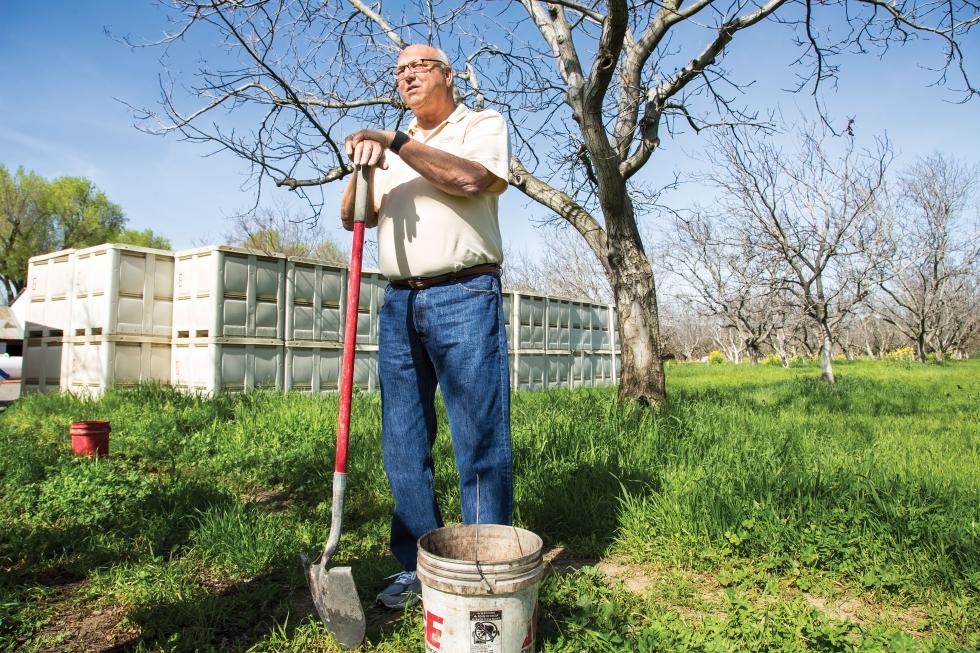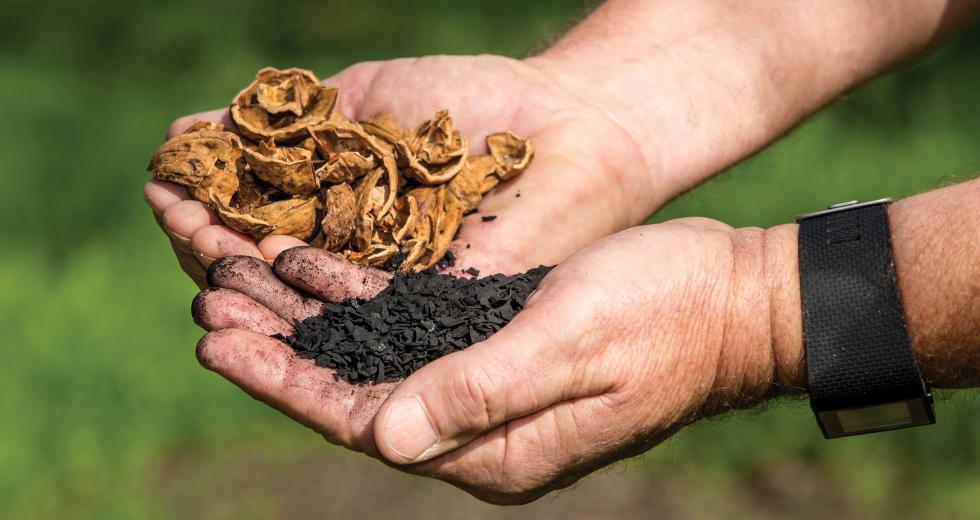Russ Lester’s property looks, at first glance, like that of many of his neighbors. He grows about 900 acres of walnut trees a few miles east of Winters. But at Dixon Ridge Farms, Lester never tills his land, and he keeps cover crops growing most of the time. He also laces the earth around his trees with biochar, charcoal-like leftovers from biomass energy production. Added to the soil, this gritty burnt material — made largely of carbon — stays there for a long time.
These simple practices have profound implications for the environment and, especially, the climate: Lester’s farm is a carbon sink, absorbing carbon atoms more rapidly than they can escape into the air.
“We’re carbon negative,” Lester says. “Most businesses and farms, and most people, are carbon positive.”
“We aren’t going to get out of our gas-guzzling cars anytime soon or rebuild our cities, and we have major infrastructure issues that won’t be solved anytime soon -— but we have the knowledge and the tools to modify right now the way that we grow food.”
Renata Brillinger, executive director, California Climate & Agriculture Network
Agriculture generates lots of carbon dioxide, the main culprit in climate change. Louise Jackson, a UC Davis soil scientist, explains that tilling the earth allows microbes to better access the soil’s organic matter, which consists of about 50 percent carbon. “And like people, they produce carbon dioxide,” Jackson says.
Due to unsustainable farming practices, staggering volumes of carbon — hundreds of billions of tons — have escaped from the planet’s soils and into the atmosphere since the dawn of agriculture. The pace of emissions has increased since the advent of mechanized farm machinery, and over time, carbon-rich soil that was almost black as coal when human fingers first broke its surface has been transformed into thin, pale dirt.
The atmosphere now contains more than 400 parts per million of carbon dioxide and counting, scientists say — up from 280 in the late 1700s. The consensus among the experts is that we must reduce that figure to 350 parts per million as soon as possible if we are to avoid the most disastrous of climate change impacts. But switching to renewable energy sources won’t be enough to stop the effects of carbon dioxide build-up that is already in the air.
That’s where farming will come in, and scientists, sustainable agriculture proponents and even Governor Jerry Brown are advocating for an overhauled system of cultivating crops that treats orchards, fields and pastures as carbon storage banks — carbon farming.
A DIFFERENT WAY TO FARM
Over time, carbon farming produces a net increase of carbon in the soil — exactly what Lester, at Dixon Ridge Farms, is doing.
Renata Brillinger, executive director of the California Climate & Agriculture Network, or CalCAN, says agriculture is both the simplest and perhaps most significant opportunity to reduce carbon dioxide build-up.
“We aren’t going to get out of our gas-guzzling cars anytime soon or rebuild our cities, and we have major infrastructure issues that won’t be solved anytime soon,” says Brillinger, whose coalition promotes agricultural solutions to climate change, like carbon farming and renewable energy development. “But we have the knowledge and the tools to modify right now the way that we grow food.”
The most basic tenet of carbon farming is to reduce tillage while adding compost and growing cover crops, which protect the ground from erosion and draw carbon from the air. Trees are planted as windbreaks to similarly shield the land from erosion. Over time, land cultivated by this system builds up carbon, and soils turn into the consistency of dark brown or black ricotta cheese.
Lester has closely tracked his soil’s organic matter content, sending soil samples to laboratories for analysis. He says the average organic matter content in nearby orchards runs about 1.5 percent.
“Ours is 3 to 4 percent,” Lester says. “For California soils, that’s very high.” That percentage is by weight, and it amounts to about 125 tons of pure carbon per acre, he says.
Russ Lester spreads biochar mulch in his walnut orchards to
encourage the growth of cover crops.

A great deal of Lester’s soil carbon has come from the biochar that he harvests from his own biomass incineration system. The shed-sized facility burns husks and shells from his autumn walnut crop, the high-heat process generating combustible gases that provide power to the farm. Meanwhile, the carbon-heavy fumes are captured and the carbon filtered out, solidified and retained as biochar. “It’s a very stable form of carbon,” Lester says. “It stays in the soil for 1,000 to 2,000 years.”
Full Belly Farm, northwest of Davis in the Capay Valley, is also actively cultivating soil carbon. Judith Redmond, the farm’s co-owner, says she still tills the land to control weeds. However, she adds compost regularly and allows sheep to graze the cover crops, breaking down the plants to make them more soil-soluble. The goal, Redmond says, is to build the soil’s microbial ecology, with high carbon levels an added benefit.
GOOD FOR THE EARTH, GOOD FOR BUSINESS
Carbon farming can also benefit the farmer. Carbon-rich soil clings aggressively to water, meaning farmers who build their soil carbon levels may need to irrigate their land less intensively — a big plus in a drought-prone climate.
It can also generate more cash. Paul Kaiser, owner of Singing Frogs Farm in Sebastopol, says he’s making four to six times as much money per crop acre as other farms — even certified organic farms — that till their soil. Kaiser hasn’t tilled his soil in years, and his soil carbon levels have steadily climbed. He says that six years ago, the organic matter content in his soil was, on average, 2.4 percent. Now, some parcels of his property contain 11 percent. Today, Kaiser’s rich, dark earth — which he describes as “gorgeous chocolate cake soil” — is astoundingly productive. Kaiser says he is logging $100,000 annually in gross produce sales for each of his three cultivated acres. He says he produces higher yields than most farmers and is also able to farm more intensively.
“Most farmers get one crop, maybe two, per year,” Kaiser says. “We’re getting between three and seven.”
But shifting to carbon-friendly practices involves a costly transition period. During this period, some land may be taken out of production. Planting trees as a windbreak reduces croppable acreage. However, Eric Toensmeier, a Yale lecturer and the author of the newly released book, The Carbon Farming Solution, says windbreaks eventually pay off, helping to increase soil health and crop yields with time. Buying new tools and equipment, and building fencing to better manage grazing animals are also expensive. These factors keep many farmers reliant on machinery, soil fumigants, pest controls and synthetic fertilizers.
FINALLY GAINING ATTENTION
Most climate-related discussions have focused on cutting fossil fuel emissions and increasing renewable energy use. But carbon farming is finally gaining global attention as a key tool to fight climate change. The practice was a significant element of the Paris climate talks in December 2015.
In January, Governor Brown wrote $20 million from [AB 32's Greenhouse Gas Reduction Fund] into his draft budget to help farmers build healthy soils and boost their land’s carbon content.
“The two weeks that I was in Paris was clearly the watershed moment for agricultural carbon sequestration really joining the conversation,” Toensmeier says. “Everywhere you went, people were talking about it.” The French government, as well as delegates from Zaire, Kenya, Nigeria and other nations, actively discussed strategies for boosting soil carbon content, Toensmeier says.
California is also taking meaningful action that could increase soil carbon levels. Early last year, Governor Jerry Brown vowed to address climate concerns, beginning with reduced carbon emissions.
“And we must manage farm and rangelands, forests and wetlands so they can store carbon,” Brown said in his Jan. 5, 2015 inaugural address before the Legislature.
The California Environmental Protection Agency has presented a climate plan that calls for increasing soil carbon in both wild and cultivated lands. The plan is part of Assembly Bill 32, the state’s Global Warming Solutions Act of 2006. Also part of AB 32 is the Greenhouse Gas Reduction Fund, which taxes large-scale emitters and has produced several billion dollars for the state since 2014. In January, Governor Brown wrote $20 million from this tax into his draft budget to help farmers build healthy soils and boost their land’s carbon content.
Local governments around the state are also giving technical support to farmers interested in transitioning from conventional growing practices to a carbon farming model.
Planting trees is one basic way of doing this. Toensmeier says the weight of wood, minus its water, is half carbon. A single acre of giant conifer forest, he notes, can contain 300 tons of carbon, including that above and below ground. However, orchards — like California’s vast and growing almond groves — are routinely pulled out of the ground and incinerated in waste heaps, and forests can go up in flames overnight.
“Carbon assets in trees can be easily lost to fire,” says Brock Dolman, co-founder of the Occidental Arts and Ecology Center in Sonoma County. “Living forest soil is a much more stable, secure place to store carbon.” Dolman’s organization advocates for conservation and biodiversity, as well as sustainable agriculture — something Dolman feels has been overlooked in the fight against climate change.
“Agriculture has been at the forefront of creating the problem of
global warming, and now agriculture has to be at the forefront of
solving it,”
Dolman says.
CAN CARBON FARMING REALLY SAVE US?
However, even if fossil fuel emissions dropped to zero tomorrow, the process of drawing all the carbon emitted over 10,000 years back into the earth will be a slow one. Rattan Lal, a prominent researcher and soil scientist at Ohio State University, says an acre of temperate cropland can reasonably be expected to draw in about 400 pounds of carbon per year. Orchards can do much better, Toensmeier says, and are generally able to draw in several tons of carbon per acre per year.
This means, even if optimal carbon farming practices were applied on all of the world’s roughly 8 billion acres of farmland and pasture, farmers could sequester several billion tons of carbon per year — only a fraction of the 250 billion tons that scientists say humans must remove from the atmosphere if we are to reduce carbon dioxide levels to 350 parts per million.
“It won’t be easy,” Lal says. “First of all we must stop adding carbon to the atmosphere. We must end fossil fuel combustion and deforestation, but it’s not happening yet.”
Brillinger, at CalCAN, agrees that turning farmland into a carbon sink will be a great challenge — especially in California. That, she explains, is because the state’s farmers grow some 400 crop types, making general lessons in carbon farming almost impossible to apply broadly.
Still, farmers everywhere bear a tremendous responsibility to change their ways as effects of climate change accelerate.
“Using natural processes to sequester carbon is a proven approach and relatively low-cost,” Lester says. “It’s not high-tech, so it doesn’t get a lot of attention, but it’s something we can do today.”




Comments
This is an awesome article a debt of gratitude is in order for sharing this useful data. I will visit your web journal consistently for some most recent post. Clean Earth NY
Its always good to learn tips like you share for blog posting. As I just started posting comments for blog and facing problem of lots of rejections. I will let you know if its work for me too. Urban Fill NY